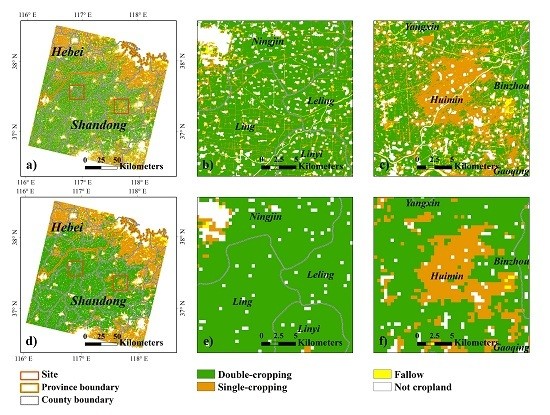High Resolution Mapping of Cropping Cycles by Fusion of Landsat and MODIS Data
Abstract
:1. Introduction
2. Materials
2.1. Study Area
2.2. Data
3. Methods
3.1. Generating 8-Day 30 m Surface Reflectance Data by Fusion of Landsat and MODIS Data
3.2. Deriving and Smoothing High-Resolution EVI Time Series
3.3. Mapping Cropping Cycles Based on Fusion EVI
3.4. Accuracy Assessment
4. Results
4.1. Mapping Results Using the Fusion Method of STARFM
4.2. Comparisons between Mapping Results Using STARFM and Using ESTARFM
5. Discussion
5.1. The Influence of the Field Sizes
5.2. Temporal Resolution of Satellite Data
5.3. Cropland Mask
6. Conclusions
Acknowledgments
Author Contributions
Conflicts of Interest
References
- FAO. Faostat Database on Agriculture. 2013. Available online: http://faostat.fao.org/ (accessed on 1 November 2017).
- Frolking, S.; Qiu, J.; Boles, S.; Xiao, X.; Liu, J.; Zhuang, Y.; Li, C.; Qin, X. Combining remote sensing and ground census data to develop new maps of the distribution of rice agriculture in China. Glob. Biogeochem. Cycles 2002, 16. [Google Scholar] [CrossRef]
- Gray, J.; Friedl, M.A.; Frolking, S.; Ramankutty, N.; Nelson, A.; Gumma, M.K. Mapping Asian Cropping Intensity With MODIS. IEEE J. Sel. Top. Appl. Earth Obs. Remote Sens. 2014, 7, 3373–3379. [Google Scholar] [CrossRef]
- Zhang, G.; Xiao, X.; Dong, J.; Kou, W.; Jin, C.; Qin, Y.; Zhou, Y.; Wang, J.; Menarguez, M.A.; Biradar, C. Mapping paddy rice planting areas through time series analysis of MODIS land surface temperature and vegetation index data. ISPRS J. Photogramm. Remote Sens. 2015, 106, 157–171. [Google Scholar] [CrossRef] [PubMed]
- Frolking, S.; Yeluripati, J.B.; Douglas, E.M. New district-level maps of rice cropping in India: A foundation for scientific input into policy assessment. Field Crop. Res. 2006, 98, 164–177. [Google Scholar] [CrossRef]
- Jain, M.; Mondal, P.; Defries, R.S.; Small, C.; Galford, G.L. Mapping cropping intensity of smallholder farms: A comparison of methods using multiple sensors. Remote Sens. Environ. 2013, 134, 210–223. [Google Scholar] [CrossRef]
- Gray, J.; Frolking, S.; Kort, E.A.; Ray, D.K.; Kucharik, C.J.; Ramankutty, N.; Friedl, M.A. Direct human influence on atmospheric CO2 seasonality from increased cropland productivity. Nature 2014, 515, 398–401. [Google Scholar] [CrossRef] [PubMed]
- Li, C.; Frolking, S.; Xiao, X.; Moore, B.; Boles, S.; Qiu, J.; Huang, Y.; Salas, W.; Sass, R.L. Modeling impacts of farming management alternatives on CO2, CH4, and N2O emissions: A case study for water management of rice agriculture of China. Glob. Biogeochem. Cycles 2005, 19. [Google Scholar] [CrossRef]
- Pittman, K.; Hansen, M.C.; Beckerreshef, I.; Potapov, P.; Justice, C.O. Estimating global cropland extent with multi-year MODIS data. Remote Sens. 2010, 2, 1844–1863. [Google Scholar] [CrossRef]
- Zhang, G.; Xiao, X.; Biradar, C.; Dong, J.; Qin, Y.; Menarguez, M.A.; Zhou, Y.; Zhang, Y.; Jin, C.; Wang, J. Spatiotemporal patterns of paddy rice croplands in China and India from 2000 to 2015. Sci. Total Environ. 2017, 579, 82–92. [Google Scholar] [CrossRef] [PubMed]
- Zhao, Y.; Bai, L.; Feng, J.; Lin, X.; Wang, L.; Xu, L.; Ran, Q.; Wang, K. Spatial and Temporal Distribution of Multiple Cropping Indices in the North China Plain Using a Long Remote Sensing Data Time Series. Sensors 2016, 16, 557. [Google Scholar] [CrossRef] [PubMed]
- Qiu, B.; Zhong, M.; Tang, Z.; Wang, C. A new methodology to map double-cropping croplands based on continuous wavelet transform. Int. J. Appl. Earth Obs. Geoinf. 2014, 26, 97–104. [Google Scholar] [CrossRef]
- Yan, H.; Xiao, X.; Huang, H.; Liu, J.; Chen, J.; Bai, X. Multiple cropping intensity in China derived from agro-meteorological observations and MODIS data. Chin. Geogr. Sci. 2014, 24, 205–219. [Google Scholar] [CrossRef]
- Liu, J.; Zhu, W.; Cui, X. A Shape-matching Cropping Index (CI) Mapping Method to Determine Agricultural Cropland Intensities in China using MODIS Time-series Data. Photogramm. Eng. Remote Sens. 2012, 78, 829–837. [Google Scholar] [CrossRef]
- Yan, H.; Liu, J.; Cao, M. Remotely sensed multiple cropping index variation during 1981–2000. ACTA Geogr. Sin. 2005, 60, 556–559. [Google Scholar]
- Ding, M.; Chen, Q.; Xiao, X.; Xin, L.; Zhang, G.; Li, L. Variation in Cropping Intensity in Northern China from 1982 to 2012 Based on GIMMS-NDVI Data. Sustainability 2016, 8, 1123. [Google Scholar] [CrossRef]
- Li, L.; Friedl, M.A.; Xin, Q.; Gray, J.; Pan, Y.; Frolking, S. Mapping Crop Cycles in China Using MODIS-EVI Time Series. Remote Sens. 2014, 6, 2473–2493. [Google Scholar] [CrossRef]
- Estel, S.; Kuemmerle, T.; Levers, C.; Baumann, M.; Hostert, P. Mapping cropland-use intensity across Europe using MODIS NDVI time series. Environ. Res. Lett. 2016, 11, 024015. [Google Scholar] [CrossRef]
- Ozdogan, M.; Woodcock, C.E. Resolution dependent errors in remote sensing of cultivated areas. Remote Sens. Environ. 2006, 103, 203–217. [Google Scholar] [CrossRef]
- Pan, Y.; Li, L.H.; Zhang, J.; Liang, S.; Zhu, X.; Sullamenashe, D. Winter wheat area estimation from MODIS-EVI time series data using the Crop Proportion Phenology Index. Remote Sens. Environ. 2012, 119, 232–242. [Google Scholar] [CrossRef]
- Shi, J.; Huang, J. Monitoring Spatio-Temporal Distribution of Rice Planting Area in the Yangtze River Delta Region Using MODIS Images. Remote Sens. 2015, 7, 8883–8905. [Google Scholar] [CrossRef]
- Pan, Y.; Hu, T.; Zhu, X.; Zhang, J.; Wang, X. Mapping Cropland Distributions Using a Hard and Soft Classification Model. IEEE Trans. Geosci. Remote Sens. 2012, 50, 4301–4312. [Google Scholar] [CrossRef]
- Wang, J.; Huang, J.; Zhang, K.; Li, X.; She, B.; Wei, C.; Gao, J.; Song, X. Rice Fields Mapping in Fragmented Area Using Multi-Temporal HJ-1A/B CCD Images. Remote Sens. 2015, 7, 3467–3488. [Google Scholar] [CrossRef]
- Son, N.T.; Chen, C.; Chen, C.; Duc, H.; Chang, L. A Phenology-Based Classification of Time-Series MODIS Data for Rice Crop Monitoring in Mekong Delta, Vietnam. Remote Sens. 2013, 6, 135–156. [Google Scholar] [CrossRef]
- Xin, Q.; Olofsson, P.; Zhu, Z.; Tan, B.; Woodcock, C.E. Toward near real-time monitoring of forest disturbance by fusion of MODIS and Landsat data. Remote Sens. Environ. 2013, 135, 234–247. [Google Scholar] [CrossRef]
- Gevaert, C.M.; Garciaharo, F.J. A comparison of STARFM and an unmixing-based algorithm for Landsat and MODIS data fusion. Remote Sens. Environ. 2015, 156, 34–44. [Google Scholar] [CrossRef]
- Zhang, W.; Li, A.; Jin, H.; Bian, J.; Zhang, Z.; Lei, G.; Qin, Z.; Huang, C. An enhanced spatial and temporal data fusion model for fusing Landsat and MODIS surface reflectance to generate high temporal Landsat-like data. Remote Sens. 2013, 5, 5346–5368. [Google Scholar] [CrossRef]
- Walker, J.J.; De Beurs, K.M.; Wynne, R.H.; Gao, F. Evaluation of Landsat and MODIS data fusion products for analysis of dryland forest phenology. Remote Sens. Environ. 2012, 117, 381–393. [Google Scholar] [CrossRef]
- Jarihani, A.A.; Mcvicar, T.R.; Van Niel, T.G.; Emelyanova, I.; Callow, J.N.; Johansen, K. Blending Landsat and MODIS Data to Generate Multispectral Indices: A Comparison of “Index-then-Blend” and “Blend-then-Index” Approaches. Remote Sens. 2014, 6, 9213–9238. [Google Scholar] [CrossRef] [Green Version]
- Wu, M.; Zhang, X.; Huang, W.; Niu, Z.; Wang, C.; Li, W.; Hao, P. Reconstruction of Daily 30m Data from HJ CCD, GF-1 WFV, Landsat, and MODIS Data for Crop Monitoring. Remote Sens. 2015, 7, 16293–16314. [Google Scholar] [CrossRef]
- Gao, F.; Masek, J.G.; Schwaller, M.; Hall, F.G. On the blending of the Landsat and MODIS surface reflectance: Predicting daily Landsat surface reflectance. IEEE Trans. Geosci. Remote Sens. 2006, 44, 2207–2218. [Google Scholar]
- Zhu, X.; Chen, J.; Gao, F.; Chen, X.; Masek, J.G. An enhanced spatial and temporal adaptive reflectance fusion model for complex heterogeneous regions. Remote Sens. Environ. 2010, 114, 2610–2623. [Google Scholar] [CrossRef]
- Hilker, T.; Wulder, M.A.; Coops, N.C.; Linke, J.; Mcdermid, G.; Masek, J.G.; Gao, F.; White, J.C. A new data fusion model for high spatial- and temporal-resolution mapping of forest disturbance based on Landsat and MODIS. Remote Sens. Environ. 2009, 113, 1613–1627. [Google Scholar] [CrossRef]
- Wu, M.; Niu, Z.; Wang, C.; Wu, C.; Wang, L. Use of MODIS and Landsat time series data to generate high-resolution temporal synthetic Landsat data using a spatial and temporal reflectance fusion model. J. Appl. Remote Sens. 2012, 6. [Google Scholar] [CrossRef]
- Earth Resources Observation and Science (EROS) Center Science Processing Architecture (ESPA). Available online: https://espa.cr.usgs.gov/ (accessed on 1 November 2017).
- Land Processes Distributed Active Archive Center (LPDAAC). Available online: https://lpdaac.usgs.gov (accessed on 1 November 2017).
- National Geomatics Center of China. Available online: http://www.globeland30.org (accessed on 1 November 2017).
- Chen, J.; Chen, J.; Liao, A.; Cao, X.; Chen, L.; Chen, X.; He, C.; Han, G.; Peng, S.; Lu, M. Global land cover mapping at 30 m resolution: A POK-based operational approach. ISPRS J. Photogramm. Remote Sens. 2015, 103, 7–27. [Google Scholar] [CrossRef]
- China Center for Resources Satellite Data and Applications. Available online: www.cresda.com (accessed on 1 November 2017).
- Gumma, M.K.; Thenkabail, P.S.; Maunahan, A.; Islam, S.; Nelson, A. Mapping seasonal rice cropland extent and area in the high cropping intensity environment of Bangladesh using MODIS 500 m data for the year 2010. ISPRS J. Photogramm. Remote Sens. 2014, 91, 98–113. [Google Scholar] [CrossRef]
- Xiao, X.; Boles, S.; Frolking, S.; Li, C.; Babu, J.; Salas, W.; Moore, B. Mapping paddy rice agriculture in South and Southeast Asia using multi-temporal MODIS images. Remote Sens. Environ. 2006, 100, 95–113. [Google Scholar] [CrossRef]
- Bolton, D.K.; Friedl, M.A. Forecasting crop yield using remotely sensed vegetation indices and crop phenology metrics. Agric. For. Meteorol. 2013, 173, 74–84. [Google Scholar] [CrossRef]
- Huete, A.R.; Didan, K.; Miura, T.; Rodriguez, E.P.; Gao, X.; Ferreira, L.G. Overview of the radiometric and biophysical performance of the MODIS vegetation indices. Remote Sens. Environ. 2002, 83, 195–213. [Google Scholar] [CrossRef]
- Guindingarcia, N.; Gitelson, A.A.; Arkebauer, T.J.; Shanahan, J.F.; Weiss, A. An evaluation of MODIS 8- and 16-day composite products for monitoring maize green leaf area index. Agric. For. Meteorol. 2012, 161, 15–25. [Google Scholar] [CrossRef]
- Wardlow, B.D.; Egbert, S.L.; Kastens, J.H. Analysis of time-series MODIS 250 m vegetation index data for crop classification in the U.S. Central Great Plains. Remote Sens. Environ. 2007, 108, 290–310. [Google Scholar] [CrossRef]
- Lobell, D.B.; Asner, G.P. Cropland distributions from temporal unmixing of MODIS data. Remote Sens. Environ. 2004, 93, 412–422. [Google Scholar] [CrossRef]
- Xiao, X.; Boles, S.; Liu, J.; Zhuang, D.; Frolking, S.; Li, C.; Salas, W.; Moore, B. Mapping paddy rice agriculture in southern China using multi-temporal MODIS images. Remote Sens. Environ. 2005, 95, 480–492. [Google Scholar] [CrossRef]
- Sakamoto, T.; Van Nguyen, N.; Ohno, H.; Ishitsuka, N.; Yokozawa, M. Spatio-temporal distribution of rice phenology and cropping systems in the Mekong Delta with special reference to the seasonal water flow of the Mekong and Bassac rivers. Remote Sens. Environ. 2006, 100, 1–16. [Google Scholar] [CrossRef]
- Sakamoto, T.; Yokozawa, M.; Toritani, H.; Shibayama, M.; Ishitsuka, N.; Ohno, H. A crop phenology detection method using time-series MODIS data. Remote Sens. Environ. 2005, 96, 366–374. [Google Scholar] [CrossRef]
- Zhang, X.; Friedl, M.A.; Schaaf, C.B.; Strahler, A.H.; Hodges, J.C.F.; Gao, F.; Reed, B.C.; Huete, A.R. Monitoring vegetation phenology using MODIS. Remote Sens. Environ. 2003, 84, 471–475. [Google Scholar] [CrossRef]
- Dong, J.; Xiao, X.; Kou, W.; Qin, Y.; Zhang, G.; Li, L.; Jin, C.; Zhou, Y.; Wang, J.; Biradar, C. Tracking the dynamics of paddy rice planting area in 1986–2010 through time series Landsat images and phenology-based algorithms. Remote Sens. Environ. 2015, 160, 99–113. [Google Scholar] [CrossRef]
- Boschetti, M.R.; Stroppiana, D.; Brivio, P.A.; Bocchi, S. Multi-year monitoring of rice crop phenology through time series analysis of MODIS images. Int. J. Remote Sens. 2009, 30, 4643–4662. [Google Scholar] [CrossRef]
- Shandong Statistical Yearbook for 2016. Available online: http://www.stats-sd.gov.cn (accessed on 1 November 2017).
- Jiangsu Statistical Yearbook for 2016. Available online: http://www.jssb.gov.cn (accessed on 1 November 2017).
- Woodcock, C.E.; Strahler, A.H. The factor of scale in remote sensing. Remote Sens. Environ. 1987, 21, 311–332. [Google Scholar] [CrossRef]
- Yu, L.; Wang, J.; Clinton, N.; Xin, Q.; Zhong, L.; Chen, Y.; Gong, P. FROM-GC: 30 m global cropland extent derived through multisource data integration. Int. J. Digit. Earth 2013, 6, 521–533. [Google Scholar] [CrossRef]
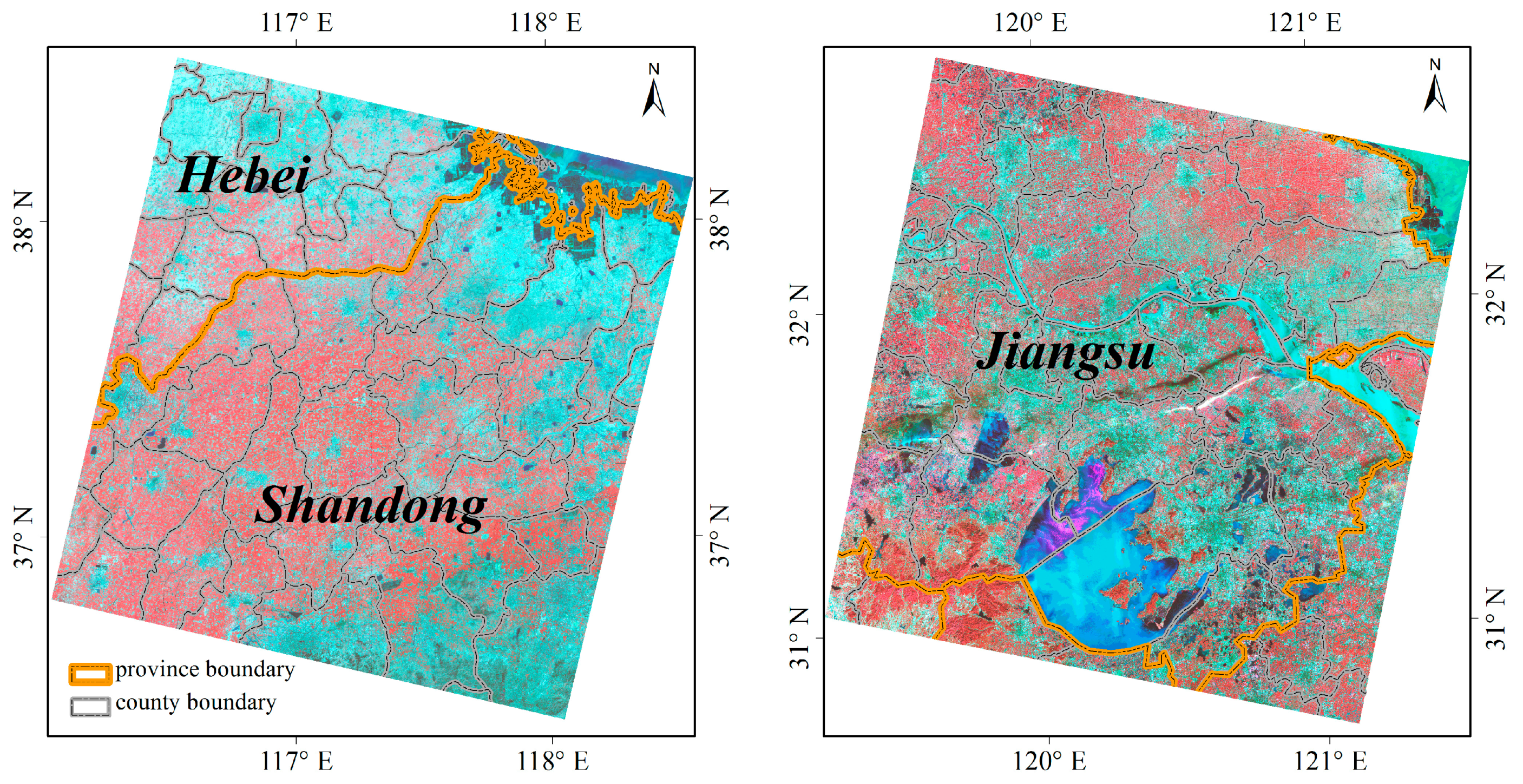
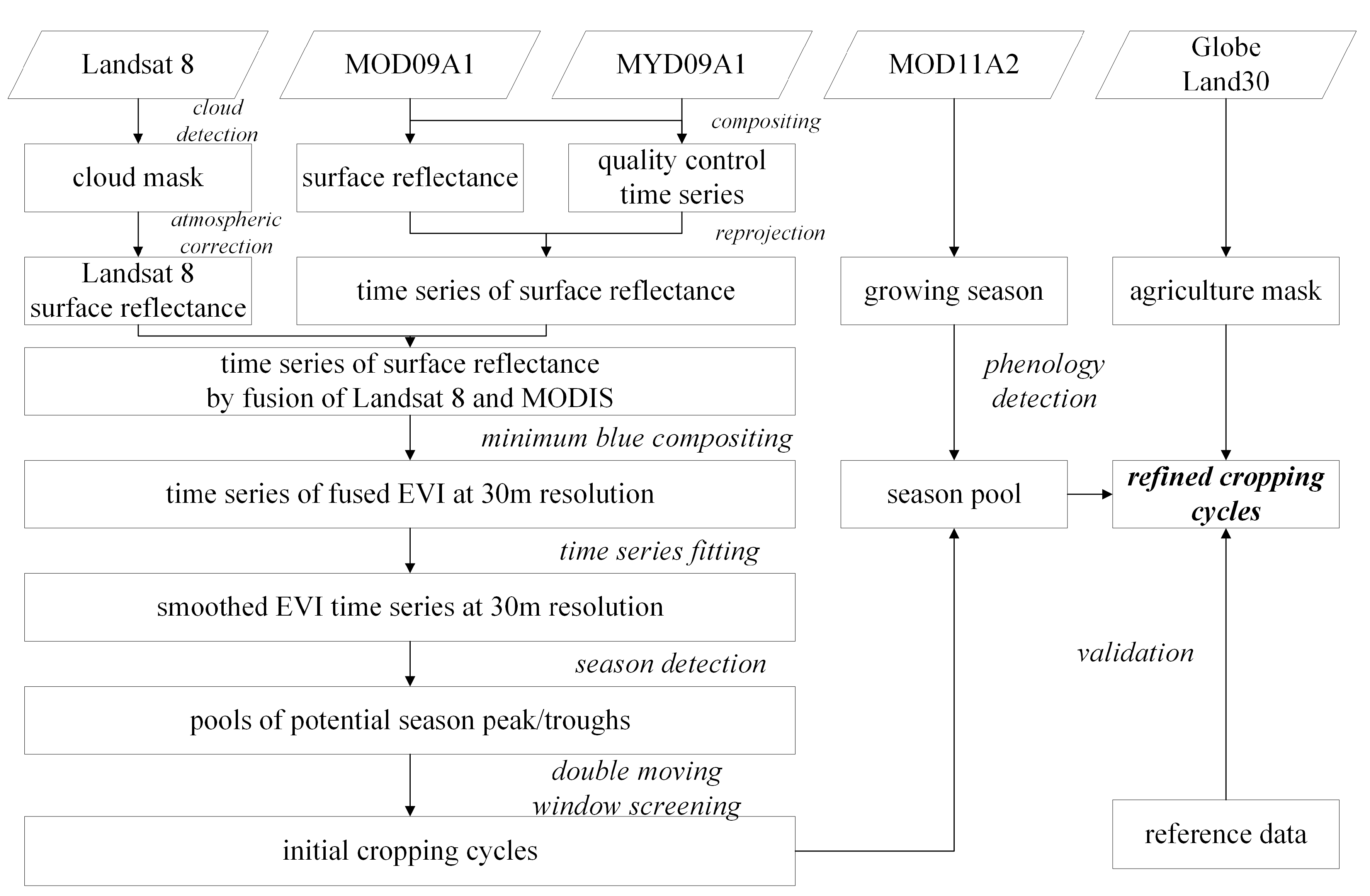


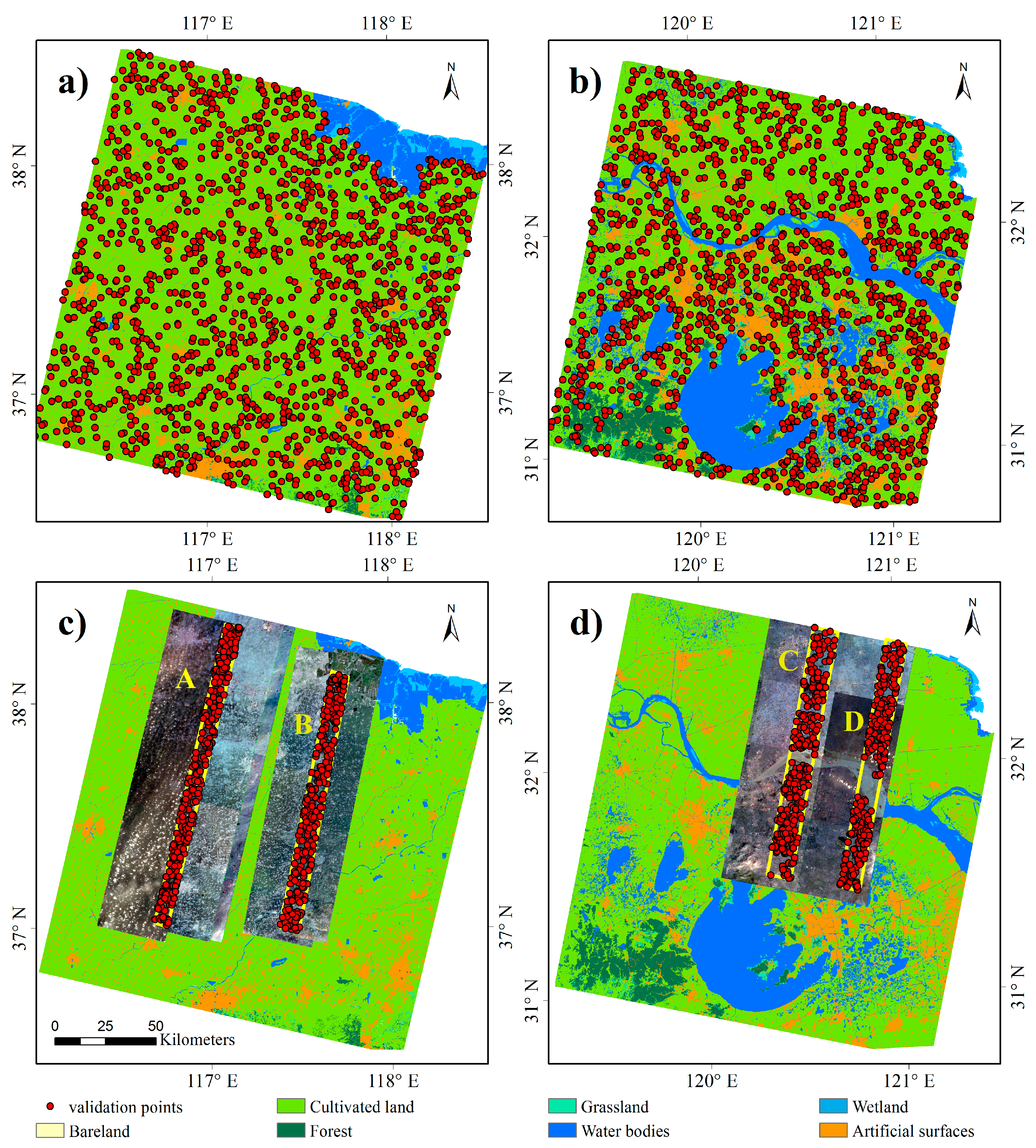


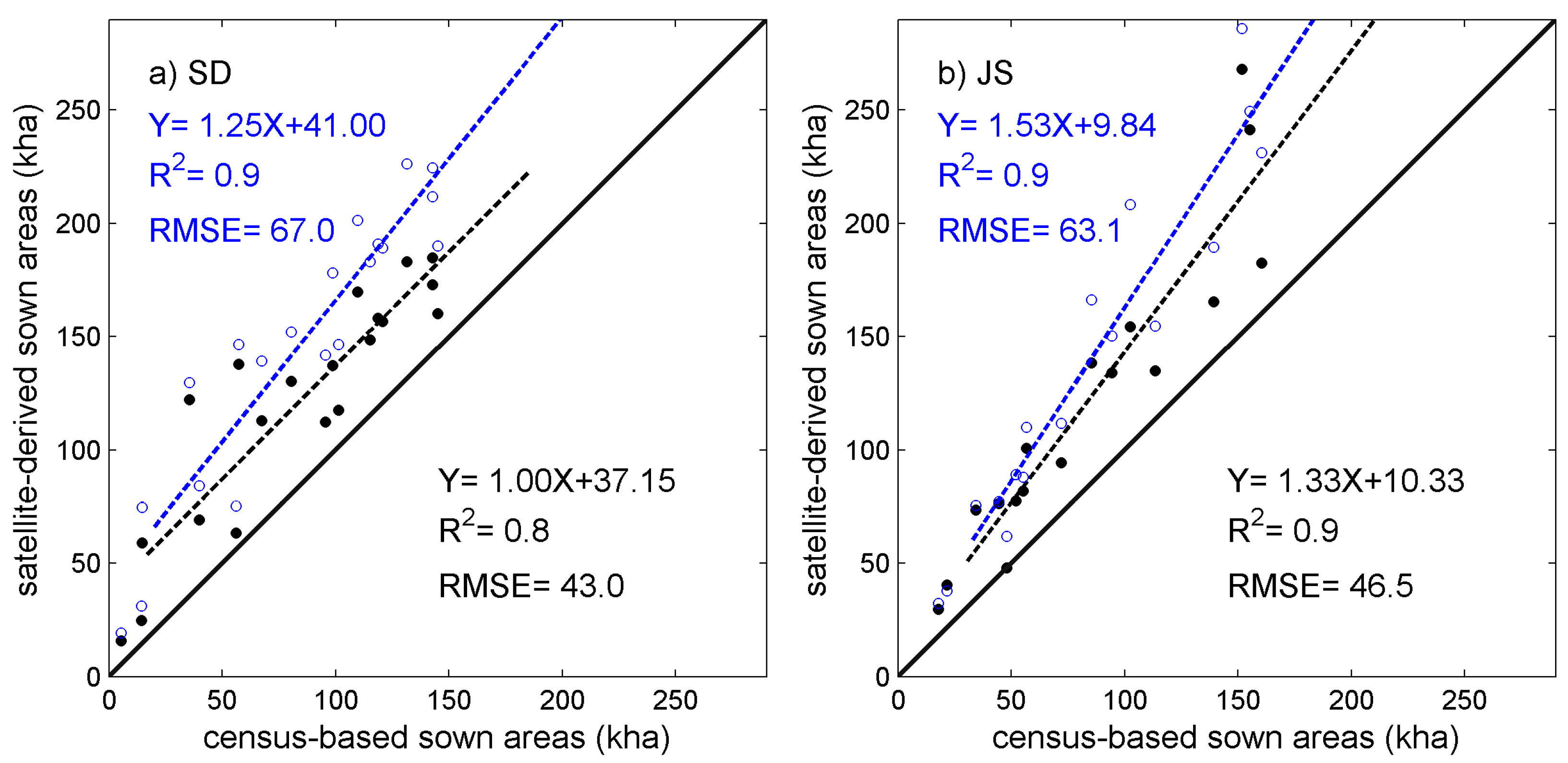
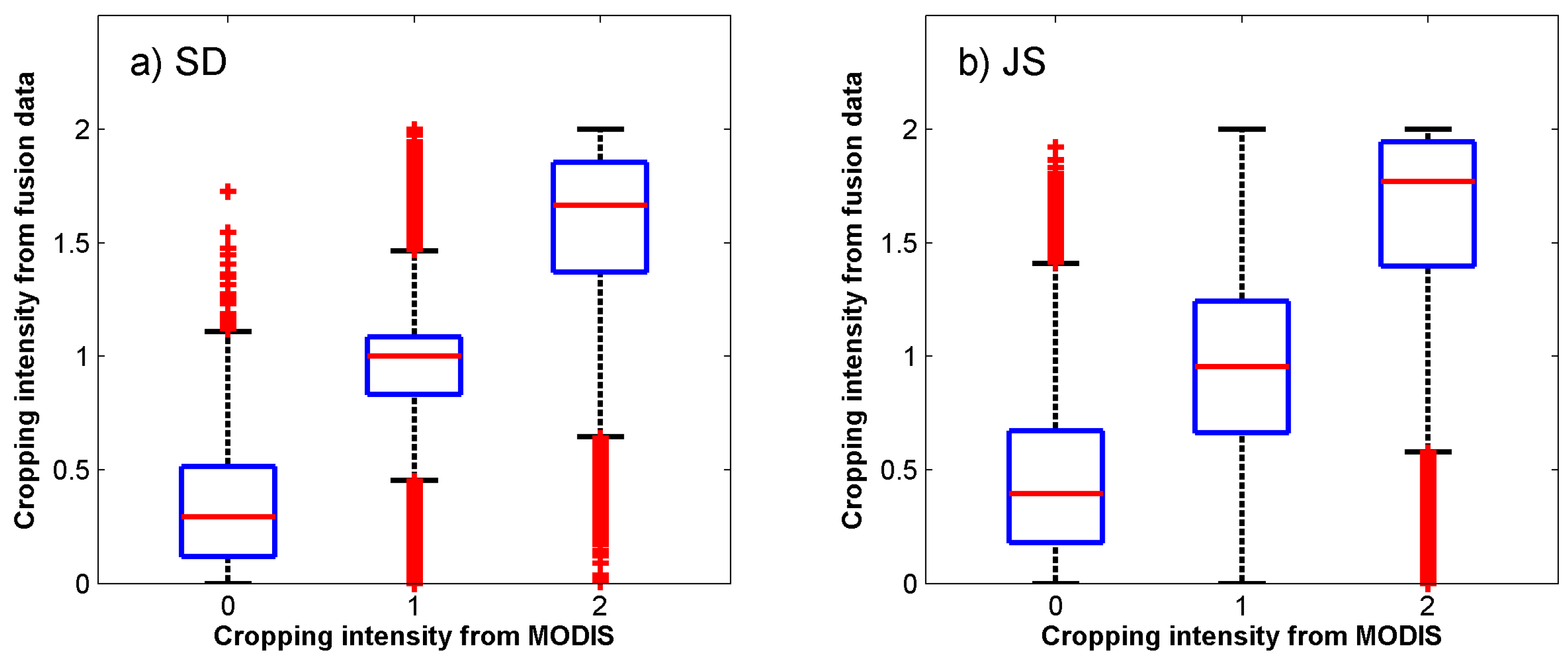
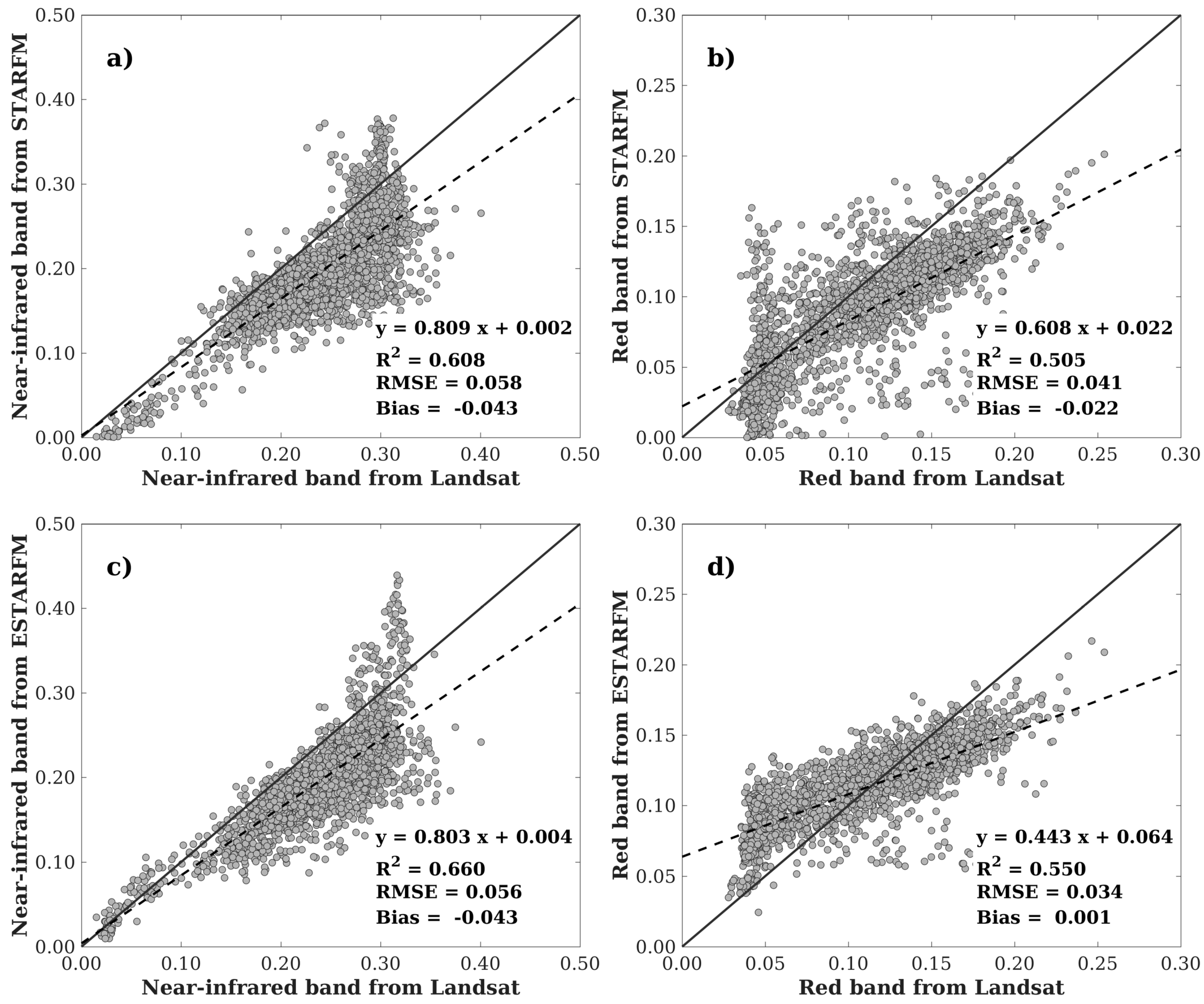
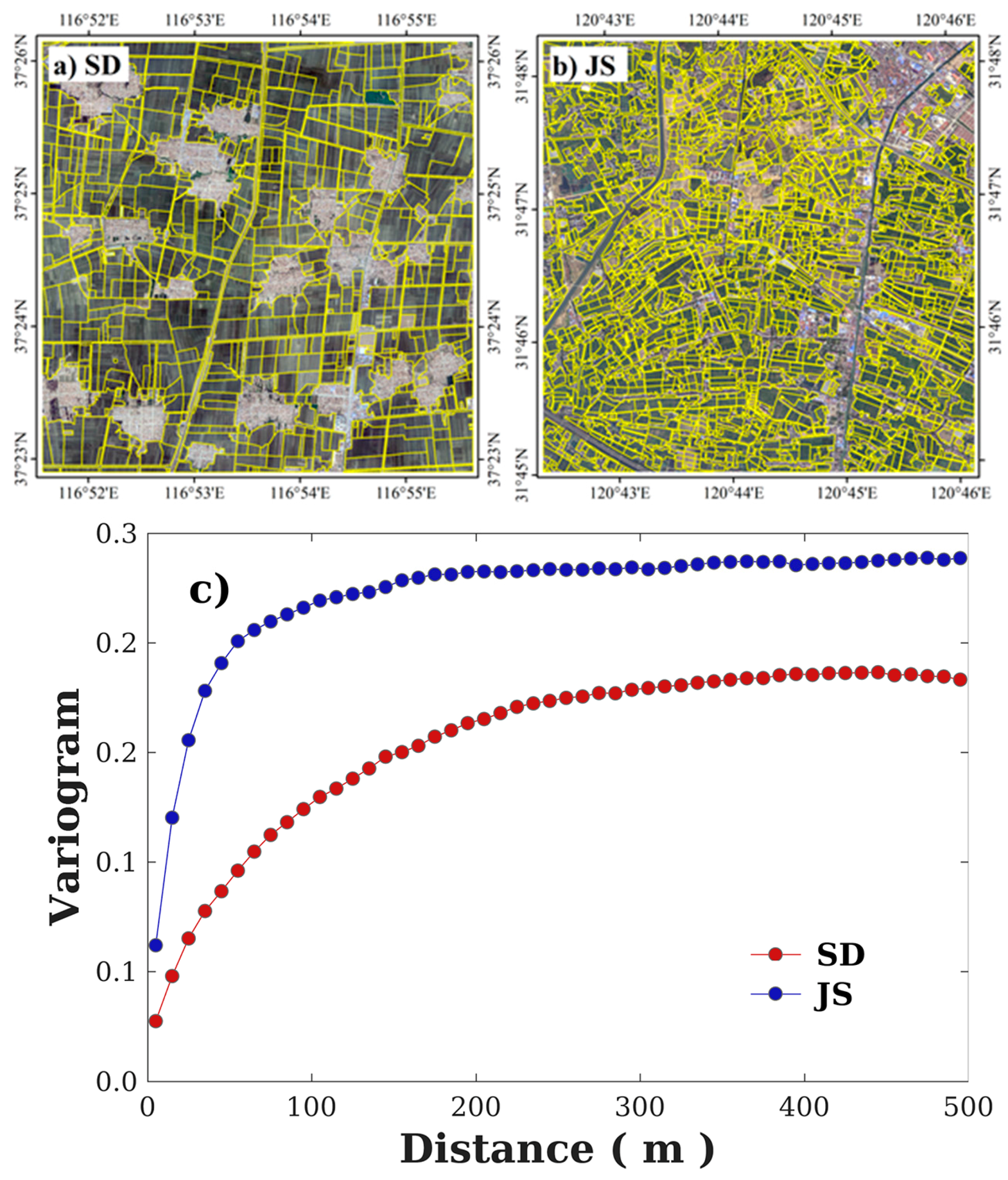
| Path, Row | Date | Scene Cloud Cover Percentage (%) | Land Cloud Cover Percentage (%) |
|---|---|---|---|
| 122, 034 | 19 January 2015 | 0.28 | 0.27 |
| 4 February 2015 | 9.14 | 9.03 | |
| 24 March 2015 | 0.81 | 0.79 | |
| 25 April 2015 | 1.86 | 1.81 | |
| 12 June 2015 | 1.59 | 0.84 | |
| 16 September 2015 | 1.54 | 1.54 | |
| 2 October 2015 | 0.09 | 0.09 | |
| 3 November 2015 | 0.72 | 0.70 | |
| 119, 038 | 27 September 2015 | 7.02 | 7.30 |
| 13 October 2015 | 3.20 | 3.29 | |
| 16 December 2015 | 6.60 | 6.71 |
| Mapped Classes | Reference Data | |||||||
|---|---|---|---|---|---|---|---|---|
| Shandong Scene | Jiangsu Scene | |||||||
| F | S | D | UA (%) | F | S | D | UA (%) | |
| F | 466 | 27 | 7 | 93.2% | 448 | 43 | 9 | 89.6% |
| S | 10 | 454 | 36 | 90.8% | 26 | 439 | 35 | 87.8% |
| D | 4 | 29 | 467 | 93.4% | 0 | 49 | 451 | 90.2% |
| PA (%) | 97.1% | 89.0% | 91.6% | 94.5% | 82.7% | 91.1% | ||
| OA (%) | 92.5% | 89.2% | ||||||
| Mapped Classes | Reference for Region A | Reference for Region B | Reference for Region C | Reference for Region D | ||||||||||||
|---|---|---|---|---|---|---|---|---|---|---|---|---|---|---|---|---|
| F | S | D | UA (%) | F | S | D | UA (%) | F | S | D | UA (%) | F | S | D | UA (%) | |
| F | 84 | 11 | 5 | 84.0 | 86 | 11 | 3 | 86.0 | 87 | 11 | 2 | 87.0 | 76 | 18 | 6 | 76.0 |
| S | 5 | 77 | 18 | 77.0 | 10 | 78 | 12 | 78.0 | 13 | 76 | 11 | 76.0 | 11 | 71 | 18 | 71.0 |
| D | 1 | 14 | 85 | 85.0 | 3 | 14 | 83 | 83.0 | 8 | 11 | 81 | 81.0 | 3 | 7 | 90 | 90.0 |
| PA (%) | 93.3 | 75.5 | 78.7 | 86.9 | 75.7 | 84.7 | 80.6 | 77.6 | 86.2 | 84.4 | 74.0 | 78.9 | ||||
| OA (%) | 82.0 | 82.3 | 81.3 | 79.0 | ||||||||||||
| OA (%) for all samples: 81.2% | ||||||||||||||||
| Mapped Classes | Reference Data | |||||||
|---|---|---|---|---|---|---|---|---|
| Shandong Scene | Jiangsu Scene | |||||||
| F | S | D | UA (%) | F | S | D | UA (%) | |
| F | 432 | 56 | 12 | 86.4% | 420 | 52 | 28 | 84.0% |
| S | 15 | 464 | 21 | 92.8% | 19 | 454 | 27 | 90.8% |
| D | 26 | 45 | 429 | 85.8% | 8 | 61 | 431 | 86.2% |
| PA(%) | 91.3% | 82.1% | 92.9% | 94.0% | 80.1% | 88.7% | ||
| OA(%) | 88.3% | 87.0% | ||||||
| GlobeLand30 Map | Ground Survey | ||
|---|---|---|---|
| Cropland | Not Cropland | User’s Accuracy | |
| Cropland | 129,940 | 28,073 | 82.2% |
| Not cropland | 1364 | 7258 | 84.2% |
| Producer’s accuracy | 99.0% | 20.5% | |
| Overall accuracy | 82.3% | ||
© 2017 by the authors. Licensee MDPI, Basel, Switzerland. This article is an open access article distributed under the terms and conditions of the Creative Commons Attribution (CC BY) license (http://creativecommons.org/licenses/by/4.0/).
Share and Cite
Li, L.; Zhao, Y.; Fu, Y.; Pan, Y.; Yu, L.; Xin, Q. High Resolution Mapping of Cropping Cycles by Fusion of Landsat and MODIS Data. Remote Sens. 2017, 9, 1232. https://doi.org/10.3390/rs9121232
Li L, Zhao Y, Fu Y, Pan Y, Yu L, Xin Q. High Resolution Mapping of Cropping Cycles by Fusion of Landsat and MODIS Data. Remote Sensing. 2017; 9(12):1232. https://doi.org/10.3390/rs9121232
Chicago/Turabian StyleLi, Le, Yaolong Zhao, Yingchun Fu, Yaozhong Pan, Le Yu, and Qinchuan Xin. 2017. "High Resolution Mapping of Cropping Cycles by Fusion of Landsat and MODIS Data" Remote Sensing 9, no. 12: 1232. https://doi.org/10.3390/rs9121232




